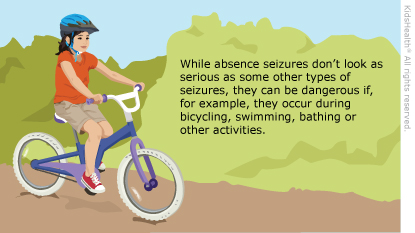Absence Seizures: How to Care for Your Child
Children who have absence seizures look like they are staring into space. They may open and close their lips loudly or make chewing motions, rub their fingers together, or flutter their eyelids. After the seizure, the child has no memory of the seizure.
If needed, medicine can help with absence seizures. Many children outgrow the seizures in their teens.


-
Your health care provider will help you create a plan for your child and talk to you about:
-
what medicines your child should take
-
if any "triggers" (such as fever, lack of sleep, or medicines) can make a seizure more likely
-
precautions your child should take while swimming (never swimming alone), bathing (showers only, no baths, and keep the bathroom door unlocked), or riding a bike (always wear a helmet and never bike alone)
-
if it's OK for your teen to drive
-
whether your child needs to wear a medical alert bracelet
-
following up with a neurologist (a doctor who specializes in brain, spine, and nervous system problems)
-
Make sure the school nurse and teachers know about your child's seizures.
-
If your child has an absence seizure:
-
Speak softly during the seizure.
-
Don't shake your child or try to get their attention.
-
If your child is walking, gently place your hands on their shoulders from behind to prevent injury.
-
Stay with your child during the seizure. If the seizure lasts more than 5 minutes, stay with your child and ask someone else to call 911.

Your child:

Your child:

What causes absence seizures? Many times, the cause of absence seizures is not known. Sometimes seizures are from genetic changes. Children with absence seizures usually have a relative who has seizures too.
How can parents help their child get the best treatment? Be sure your child follows the health care provider's recommendations. If your child has another seizure, keep a record of:
This information will help the health care provider find the best treatment for your child's seizures.